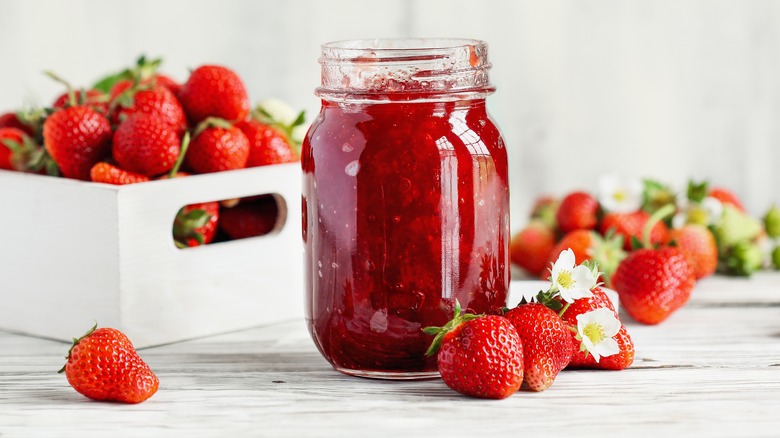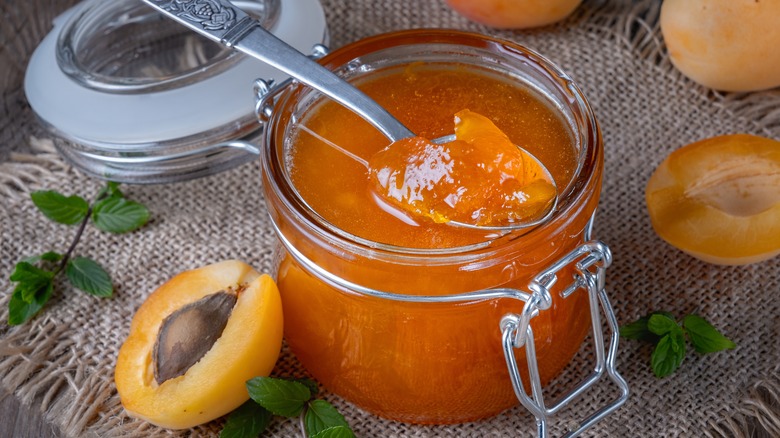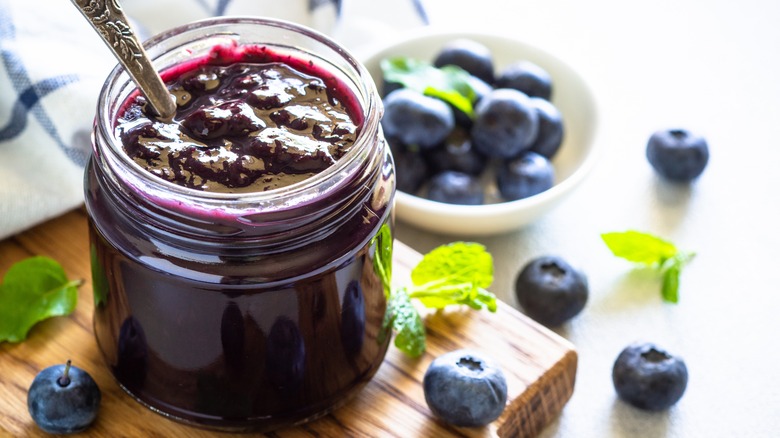How Long Will Jelly Usually Stay Good After Opening?
You probably have a good idea of when you bought whatever fresh fruit or vegetables, sliced cheese, and raw meats are hanging out in your fridge. Condiments, however, are more difficult to keep track of. They're less perishable than the fresh foods we buy and can last months in the refrigerator due to their highly-acidic and sugary nature. It's easy for them to fade into the background, go unexamined, and end up hanging around for so long that we forget when we acquired it.
But, while they're hardy enough to stick around for a while, condiments like jelly can indeed spoil and potentially cause illness. As soon as you open the seal on a jar of jelly and expose it to the outside environment, the clock starts ticking. The USDA advises us to only keep store-bought jelly in the fridge for up to six months after opening it. After this point, unwanted fungi, yeasts, and other microbes may be present in greater quantities — potentially enough to make a person sick.
In the air tonight
Keeping fruit edible by making it into jelly, jam, or preserves is a great way to enjoy the produce outside of the peak summer months. While jelly remains sealed in its jar, it can last a long time (Smuckers says about two years for its fruit spreads, to give you an example). As long as it's protected from outside elements, jelly is inherently self-preserving. Sugar and acid, are natural preservatives and create an environment in which bacteria find it difficult to survive, therefore mitigating spoilage.
But once you open that airtight seal, the jelly gets exposed to the world around it, which can include bacteria and mold spores present in the air. This typically won't have much of an effect on the jelly right away, but with time, these microorganisms — some of which are toxic to humans — will have the opportunity to propagate.
The six-month rule is contingent upon the jelly being stored in the fridge. But, jelly is a condiment that doesn't technically require refrigeration. It's OK to leave even opened jelly unrefrigerated; it won't go bad overnight. But if you don't refrigerate your jelly, plan to use it up soon — within a month of opening — to avoid nasties.
Just scraping by
Refrigeration is the best way to extend the life of jelly, as low temperatures inhibit the growth of potentially harmful microorganisms. Another way to keep jelly safe and edible for as long as possible is to only ever use clean utensils to scoop the preserve from the jar. Double-dipping may be convenient, but plunging a knife that has foreign bacteria on it (say, from your toast or butter) into the jar can leave behind bacterial and fungal cells that will multiply over time.
If you open the jar and see mold spots — typically fuzzy-looking and white or greenish — hold it right there. Some people habitually scrape off mold and eat around it, and while in most cases they won't get sick if they accidentally eat some, it's inadvisable. Even if you remove the mold, it could leave behind toxic compounds (called mycotoxins) that aren't visible to the human eye. Some moldy foods are safe to eat, but jellies and jams aren't among them. According to the USDA, "Microbiologists recommend against scooping out the mold and using the remaining condiment" for safety's sake.
While all these guidelines are well and good, it's best to trust your senses. As jelly goes bad, it can produce yeasty or alcohol-like odors and flavors, and ingredients start to separate. If you grab a jar from the fridge and detect any hint of funky sights or smells, toss it. The last thing you want with your perfect PB&J is a side of nausea.


